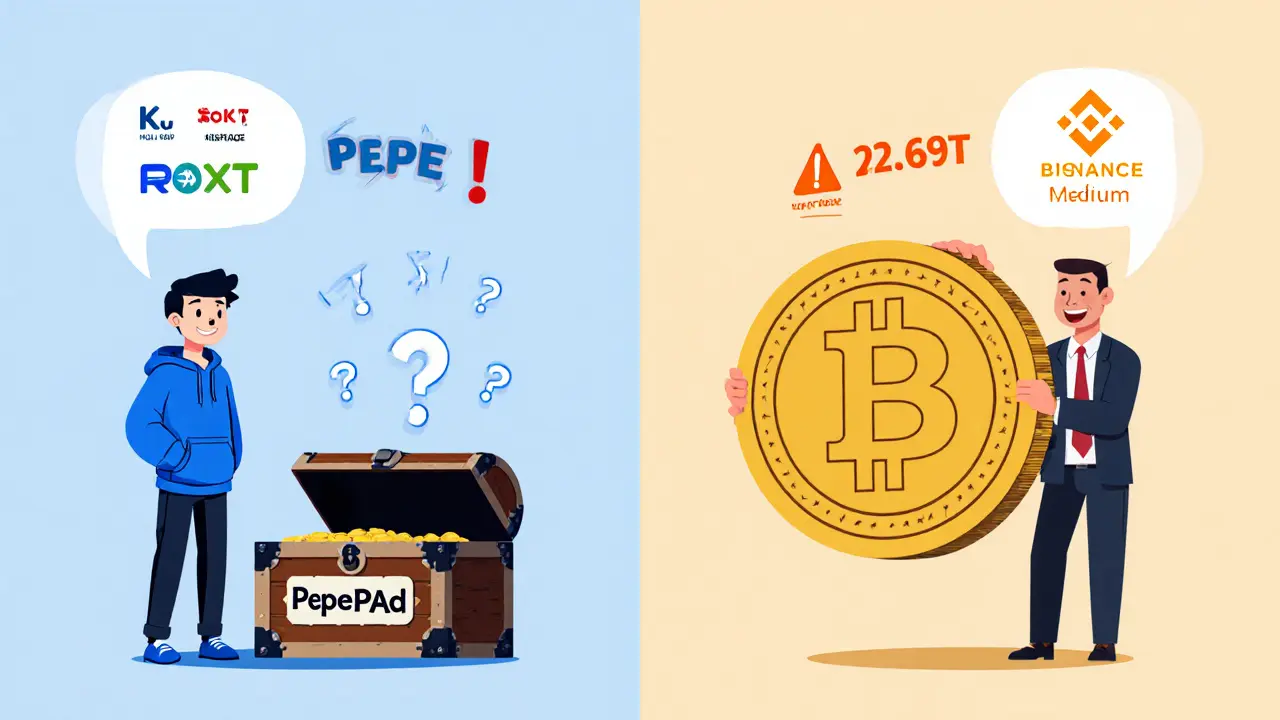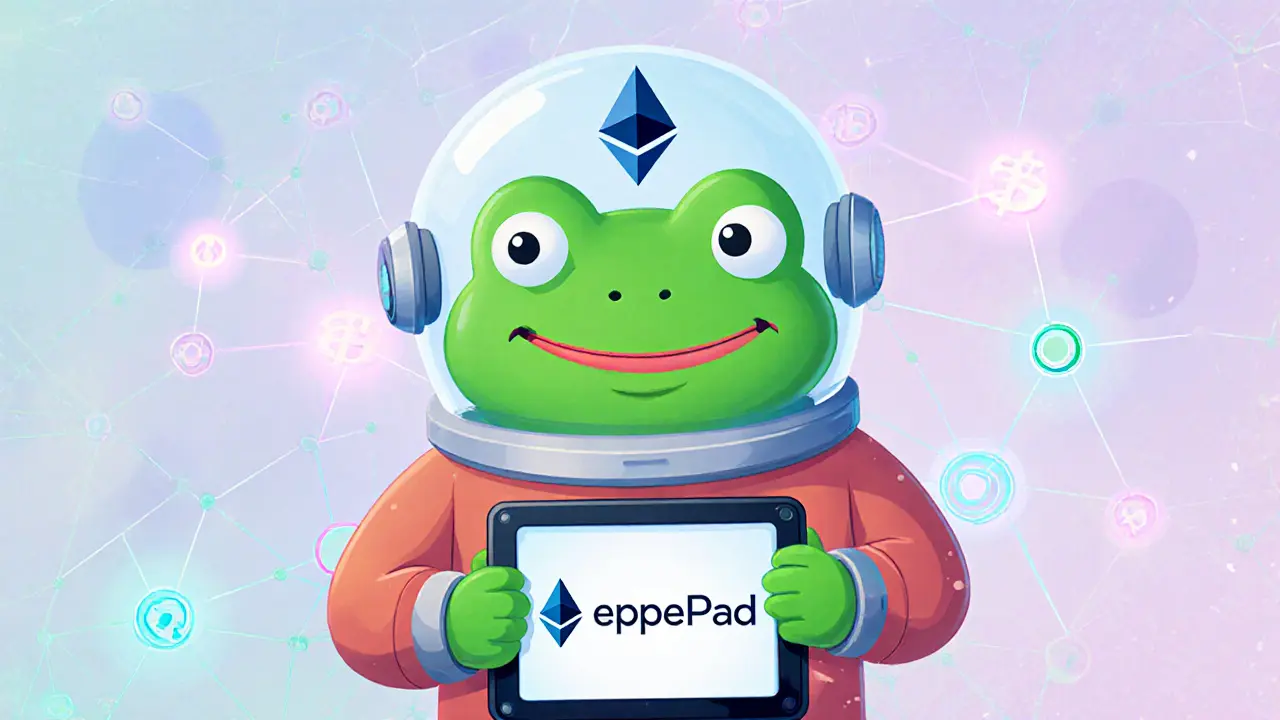PepePAD vs PEPE Coin Comparison Tool
Token Comparison Overview
| Aspect | PepePAD (PEPE) | PEPE Coin |
|---|---|---|
| Launch Date | Late 2024 (Pre-listing) | April 2023 |
| Blockchain | Ethereum (ERC-20) | Ethereum (ERC-20) |
| Max Supply | Not Disclosed | 420.69 trillion tokens |
| Burn Mechanism | Unclear, No Schedule | Periodic Token Burns |
| Transaction Tax | 0% (Claimed) | 0% (Currently) |
| Exchange Availability | Awaiting Listing (KuCoin, OKX) | Listed on Binance, Kraken, KuCoin, Uniswap |
| Community Focus | Early Stage, Building Presence | Established Meme Community |
PepePAD Risk Level: High
PEPE Coin Risk Level: Medium
* Risk levels based on current information and market conditions
- Launch Timing: PEPE coin launched in 2023; PepePAD is pre-listing
- Supply Control: PEPE has a fixed supply; PepePAD supply is undisclosed
- Deflationary Mechanism: PEPE uses token burns; PepePAD lacks this feature
- Market Presence: PEPE is widely traded; PepePAD awaits listing
- Community Maturity: PEPE has established community; PepePAD is building
TL;DR
- PepePAD (PEPE) is a meme‑style ERC‑20 token built on Ethereum.
- It is still awaiting exchange listings, so price data is scarce.
- PEPE coin is the older, already‑traded meme token with a 420.69trillion‑token max supply.
- Both tokens have no tax on trades, but only PEPE has a known deflationary burn mechanism.
- Investors should treat both as high‑risk, community‑driven assets.
Introducing PepePAD (PEPE)
When you first see the name PepePAD is a meme‑focused cryptocurrency that follows the ERC‑20 standard on the Ethereum blockchain, the obvious question is: what does it actually do? In short, PepePAD aims to ride the wave of internet‑culture coins that use the famous Pepe the Frog meme as a branding hook. Unlike many meme tokens that launch directly on decentralized exchanges, PepePAD has announced a pending listing on major platforms such as KuCoin and OKX, but an official market price has not been disclosed yet.
How PepePAD Differs From the Established PEPE Coin
Most searches for "PepePAD" end up mixing it with the better‑known PEPE coin. Here’s a clear side‑by‑side view:
| Aspect | PepePAD (PEPE) | PEPE Coin |
|---|---|---|
| Launch date | Late 2024 (pre‑listing) | April2023 |
| Blockchain | Ethereum (ERC‑20) | Ethereum (ERC‑20) |
| Maximum supply | Not publicly disclosed | 420.69trillion tokens (initial) |
| Burn mechanism | Unclear, no published schedule | Periodic token burns reduce supply |
| Transaction tax | 0% (as claimed) | 0% (currently) |
| Exchange availability | Awaiting listing (KuCoin, OKX mentioned) | Listed on Binance, Kraken, KuCoin, Uniswap, etc. |
| Community focus | Early‑stage, building social‑media presence | Established meme community across Reddit, Twitter, Discord |
Technical Foundations: Ethereum and ERC‑20
Both tokens run on Ethereum a public, proof‑of‑stake blockchain that hosts smart contracts and decentralized applications. By conforming to the ERC‑20 standard token interface that ensures compatibility with wallets, DEXs, and other Ethereum‑based services, PepePAD inherits all of Ethereum's security guarantees while also being subject to the same network congestion and gas‑fee dynamics.
Because Ethereum operates 24/7, you can transfer the token at any hour, but during peak usage periods the gas price may climb, making small trades less economical. This is a shared pain point for most meme tokens that lack layer‑2 scaling solutions.

Tokenomics: Supply, Burns, and Taxes
PEPE coin launched with a massive 420.69trillion token cap and employs regular token burns to shrink the circulating supply over time. Those burns are recorded on-chain, giving transparency to investors who track scarcity trends.
In contrast, PepePAD has not released a whitepaper detailing its total supply or burn schedule. The project does market itself as “no‑tax,” meaning there are no built‑in fees on transfers-a feature that can attract high‑volume traders looking to avoid the 1‑2% fees some other meme tokens levy.
Without a known deflationary mechanism, PepePAD’s price outlook will rely heavily on community hype and future exchange listings. Investors should treat the token as speculative until concrete token‑omics are published.
How to Buy and Store PepePAD
- Set up an Ethereum‑compatible wallet (MetaMask, Trust Wallet, or a hardware wallet like Ledger).
- Obtain some ETH to cover gas fees.
- Once PepePAD lists on an exchange, create an account on the platform (e.g., KuCoin or OKX) and complete KYC if required.
- Deposit ETH or USDC, locate the PEPE‑PAD trading pair, and place a market or limit order.
- Transfer the purchased tokens to your personal wallet for full custody.
If you prefer a fully decentralized route, keep an eye on Uniswap’s token list. When the contract is verified, you can add the contract address manually and trade directly from your wallet.
Risks, Red Flags, and Mitigation Tips
Investing in meme‑driven tokens carries a unique risk profile:
- Price volatility: Social‑media sentiment can swing token prices by dozens of percent in hours.
- Lack of utility: Neither PepePAD nor PEPE coin offer a functional use case beyond speculation.
- Regulatory uncertainty: Meme coins may attract scrutiny for being unregistered securities.
- Liquidity risk: Until PepePAD lists on a reputable exchange, you may struggle to sell the token without incurring steep slippage.
Mitigation strategies include limiting exposure to a small portion of your portfolio, using stop‑loss orders on exchanges that support them, and staying active in community channels to gauge upcoming announcements.
Community and Cultural Impact
The meme aspect isn’t just a marketing gimmick-it’s the core driver of value. PEPE coin’s community has built a vibrant ecosystem of memes, Discord chats, and Twitter threads that keep the token in the public eye. PepePAD is still nurturing that ecosystem; early adopters typically share meme‑generated content, hold community contests, and push for exchange listings. This grassroots approach can create rapid momentum, but it also means the token’s future hinges on the community’s ability to stay relevant.
Bottom Line
PepePAD (PEPE) represents the next wave of meme‑centric tokens trying to capture the hype that propelled the original PEPE coin to multi‑million‑dollar market caps. Its technical foundation on Ethereum ensures compatibility, but the lack of published tokenomics and exchange listings makes it a high‑risk, high‑reward speculation. If you’re comfortable with volatility and enjoy being part of a meme‑driven community, keeping a modest allocation could be fun. For anyone seeking stable returns or real‑world utility, traditional assets or established cryptocurrencies remain a safer bet.

Frequently Asked Questions
Is PepePAD the same as PEPE coin?
No. PepePAD is a newer, still‑unlisted token that shares the meme theme, while PEPE coin launched in 2023 and is already traded on multiple exchanges.
Where can I buy PepePAD?
Currently you’ll need to wait for its official listing on platforms like KuCoin or OKX. Once listed, you can purchase it with ETH or stablecoins via those exchanges or on a DEX such as Uniswap.
Does PepePAD have a token burn or supply limit?
The project has not published a maximum supply or burn schedule, so those details remain unknown at this stage.
Is there a transaction tax on PepePAD?
The token is marketed as a 0% tax token, meaning there are no built‑in fees on buys or sells.
What are the main risks of investing in meme tokens like PepePAD?
Key risks include extreme price volatility, lack of intrinsic utility, potential regulatory action, and limited liquidity until the token secures exchange listings.


Wow, this is a meme coin extravaganza.
PepePAD looks interesting but the lack of supply info is a red flag. Without a clear tokenomics model, it feels speculative. You should keep an eye on the official announcements.
When evaluating a nascent meme token such as PepePAD, it is incumbent upon the prospective investor to adopt a methodical framework that scrutinises not only the superficial branding but also the underlying technical scaffolding, the governance structure, and the strategic roadmap that the development team has articulated. The fact that the token adheres to the ERC‑20 standard ensures compatibility with existing wallet ecosystems and facilitates interoperability across decentralized exchanges, which is a baseline requirement for any Ethereum‑based asset. However, the conspicuous absence of a publicly disclosed maximum supply and a burn schedule introduces a degree of opacity that may erode confidence among risk‑averse participants. Moreover, the projected listings on centralized venues like KuCoin and OKX, while promising, remain speculative until formal announcements and audit reports are released. It is also worth noting that the zero‑tax claim, though attractive to high‑frequency traders, does not inherently confer any intrinsic value; rather, it merely reduces friction in token movement. Consequently, investors should calibrate their exposure to a proportion of their portfolio that they are prepared to relinquish entirely, given the high volatility endemic to meme‑driven assets. A prudent approach would involve diversifying across multiple established tokens, employing stop‑loss mechanisms where available, and maintaining vigilance over community channels for any emergent developments. In sum, while PepePAD possesses the archetypal meme appeal that can catalyse rapid price surges, the current informational gaps mandate a cautious, data‑driven investment stance.
Indeed, the lack of a burn schedule is concerning :)
Oh, look, another "innovative" meme token that promises the moon without actually saying where the rocket is built. It's like watching a circus where the clown promises a grand finale but never shows up with the actual act. The hype train is already leaving the station, and everyone seems eager to buy a ticket, but the tracks? Still being laid down. If you ask me, this is the same old story-glossy marketing, vague tokenomics, and a waiting room full of would‑be investors. And let's not forget the classic line: "Zero tax!" as if that alone magically guarantees value. Spoiler: it doesn't.
The whole meme‑coin narrative is a façade designed to distract from the fact that regulatory bodies are watching these projects like a hawk. While everyone is busy sharing the latest Pepe meme, the real question is whether the developers have any plan beyond exploiting social media trends. If you think this is just harmless fun, you might be overlooking the systemic risks that come with unchecked token issuance.
Hey folks, if you’re curious about getting in early, just remember to store your tokens in a secure wallet and keep an eye on the official channels for listing updates. Good vibes! 😊
Definitely keep your private keys safe; the community will post any official announcements there.
PepePAD feels like a wild roller‑coaster you’re forced onto without a safety harness. The adrenaline rush is real, but the drop could be brutal. Still, if you love that high‑risk hustle, it might be worth a tiny slice of your portfolio. Just don’t go all‑in.
From an analytical standpoint, the token suffers from an information asymmetry problem; without transparent tokenomics, the market efficiency hypothesis collapses, leading to adverse selection.
Looks like a fun project, I’ll keep an eye on it.
I appreciate the community effort behind PepePAD. While the tokenomics are still a mystery, the enthusiasm of early adopters can sometimes translate into genuine momentum. Let’s hope the team releases more details soon, and we can all make informed decisions together.
It is morally indefensible to promote a financial instrument that thrives on pure speculation and offers no substantive utility. The allure of meme‑driven hype, while seemingly innocuous, disguises a deeper ethical dilemma: encouraging individuals-often inexperienced-to gamble with funds they cannot afford to lose. This disregard for prudent financial stewardship reflects a broader cultural malaise where sensationalism eclipses responsibility. We must challenge the narrative that equates meme popularity with legitimate investment merit and instead champion transparency, accountability, and the protection of vulnerable participants in the crypto ecosystem.
Sounds cool, might give it a try later.
Honestly, i think most of these meme tokens are just scams, dont waste ur time.
One cannot help but observe the paradoxical nature of platforms that simultaneously court the masses with overtly simplistic branding while emulating the elitist lexicon of high‑finance, thereby constructing an illusion of legitimacy that is as hollow as the unannounced token supply they so proudly proclaim. The veneer of sophistication fails to mask the underlying vacuity, and the community’s fervor, though palpable, merely serves to amplify an echo chamber wherein critical scrutiny is systematically discouraged. In this environment, the pursuit of substantive value becomes secondary to the pursuit of virality, a transformation that betrays the very principles of transparent market dynamics. Thus, any engagement with such an entity should be undertaken with a calibrated sense of skepticism, lest one be subsumed by the fleeting euphoria that these meme‑centric constructs so deftly cultivate.